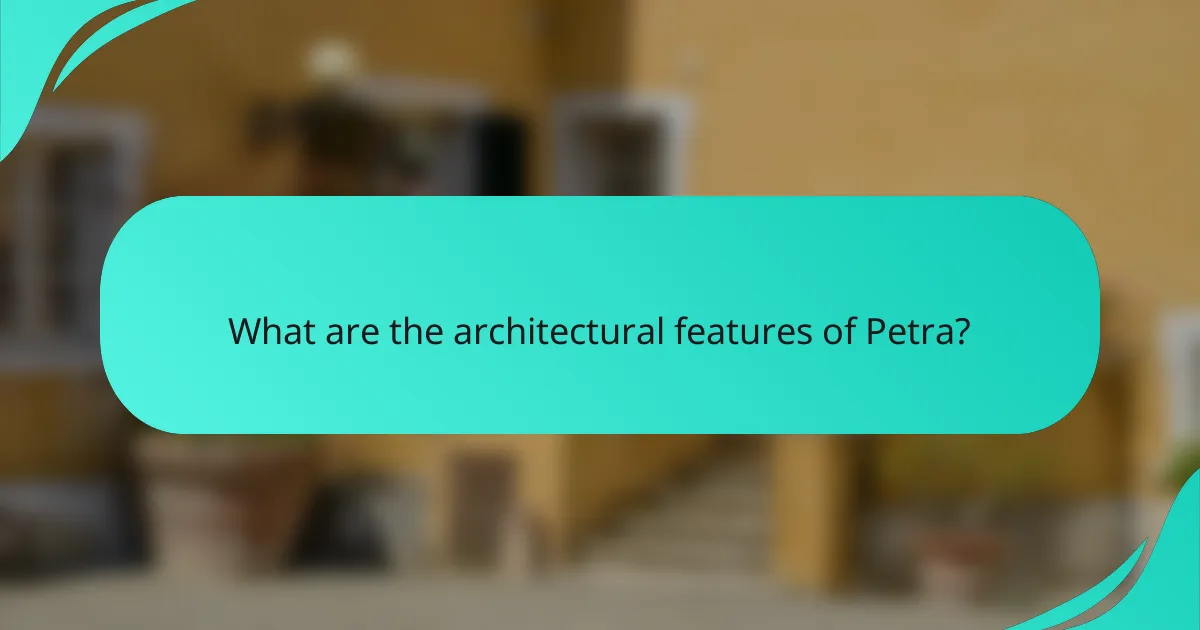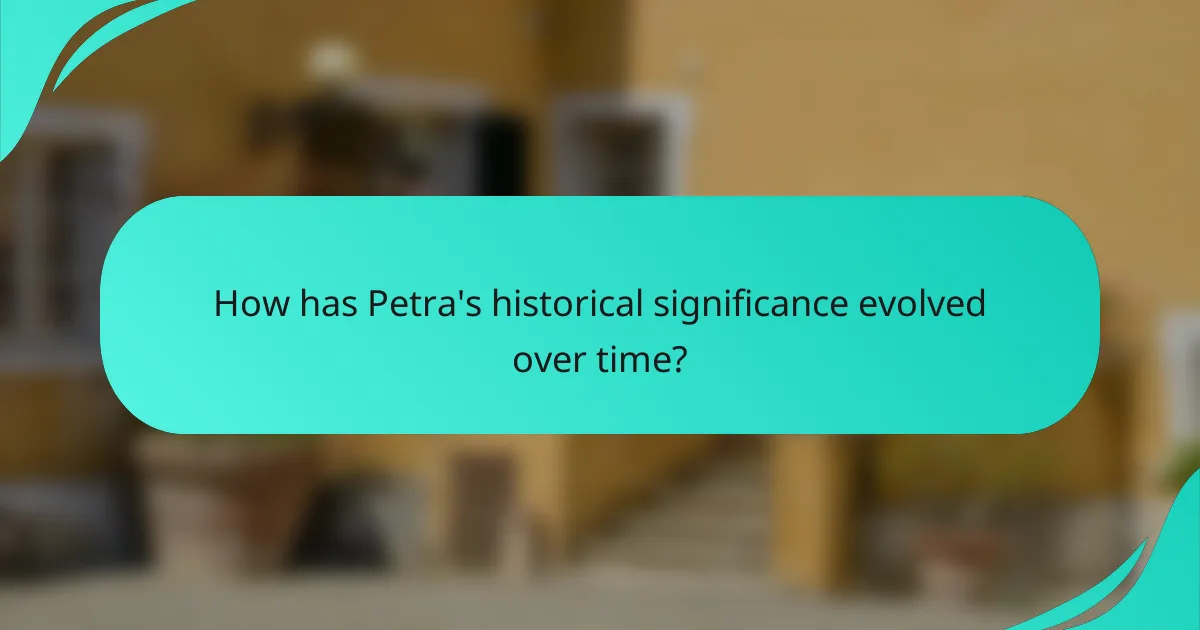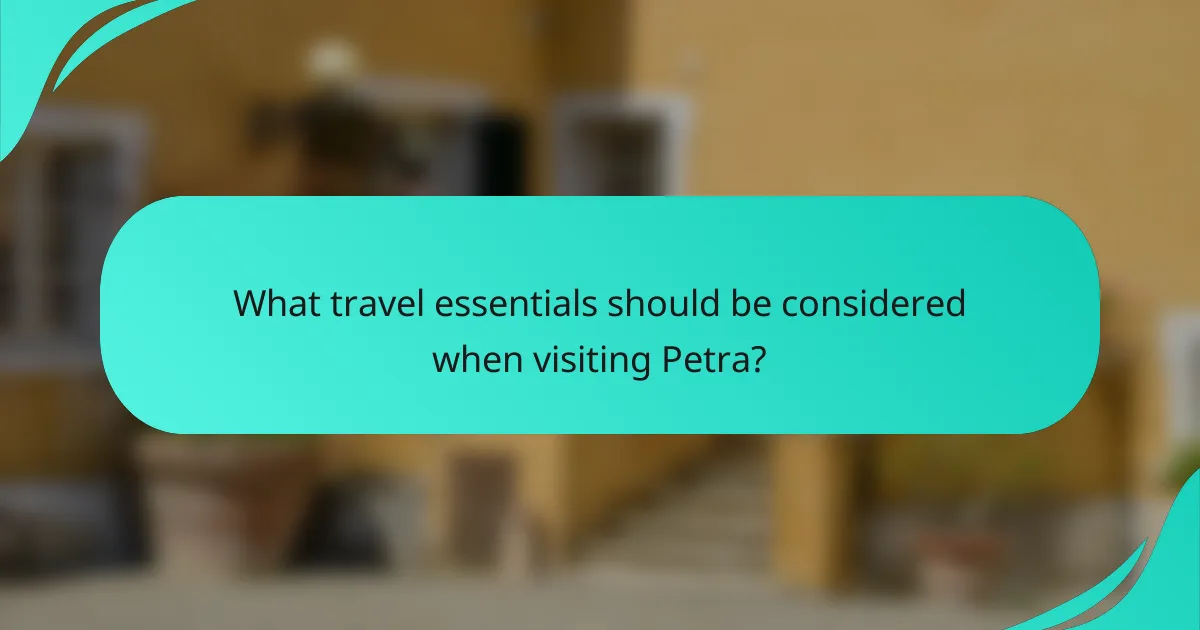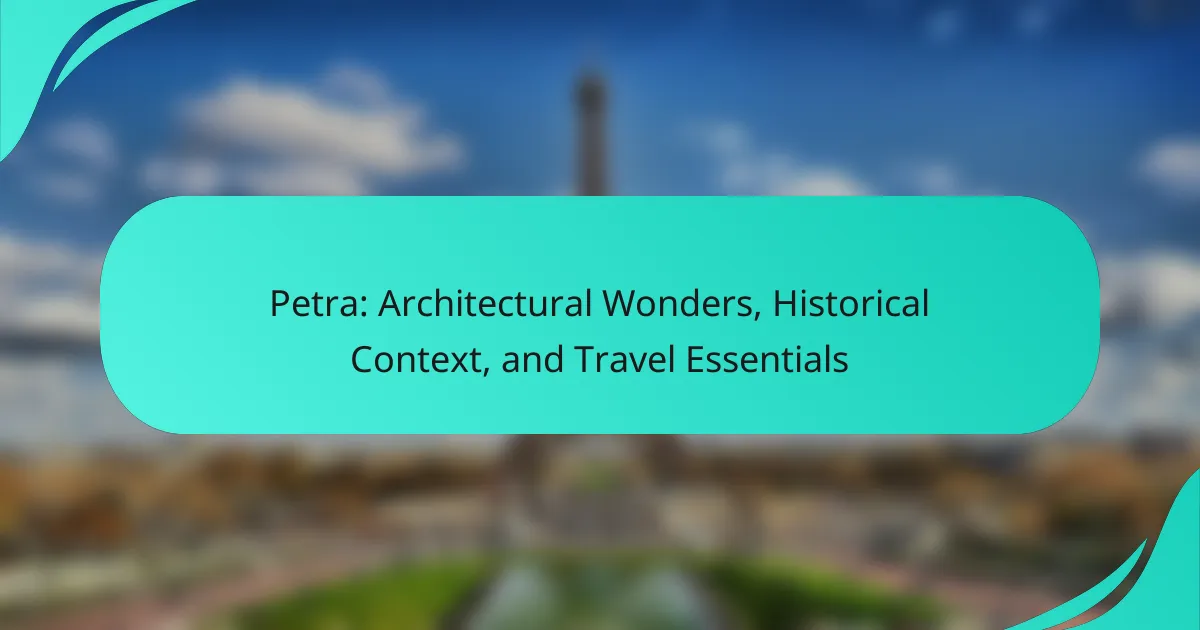Petra is a UNESCO World Heritage Site known for its stunning rock-cut architecture and historical significance as a former trade hub. This article explores its architectural wonders, including Al-Khazneh and the intricate water management systems, alongside the cultural context of the Nabateans. Practical travel tips will also be provided to enhance your visit, ensuring a memorable experience in this ancient city.

What are the architectural features of Petra?
Petra features remarkable rock-cut architecture, intricate facades, and advanced water management systems. Its most iconic structure, Al-Khazneh, showcases Hellenistic influences with elaborate carvings. The city’s strategic location along trade routes contributed to its architectural diversity, blending Eastern and Western styles. Unique attributes include the use of local sandstone, which changes color throughout the day, and sophisticated tombs that reflect the Nabatean culture.
How do the rock-cut structures define Petra’s landscape?
The rock-cut structures of Petra uniquely shape its landscape by seamlessly integrating architecture with natural rock formations. These structures, carved from sandstone cliffs, showcase advanced engineering and artistic skills of the Nabataeans. The most notable examples include Al-Khazneh and the Monastery, which stand as iconic representations of this architectural style. Their intricate facades and strategic placements enhance Petra’s dramatic topography, creating a visually stunning and historically rich site that attracts travelers and historians alike.
Which iconic buildings should visitors not miss?
Visitors should not miss the Treasury, Monastery, and Roman Theater in Petra. These iconic structures showcase the advanced Nabatean architecture and rich history of the site.
The Treasury, known as Al-Khazneh, features intricate carvings and stands at 39 meters tall. The Monastery, or Ad-Deir, is larger and offers stunning views from its cliffside location. The Roman Theater, carved into the rock, highlights Petra’s cultural significance during the Roman period.
Each of these buildings reflects unique attributes of Petra’s architectural style and historical context, making them essential stops for any visitor.
What materials were used in Petra’s construction?
Petra’s construction primarily utilized sandstone, a readily available material in the region. The Nabataeans skillfully carved this rock to create intricate facades and structures. Other materials, such as limestone and basalt, were occasionally used for specific architectural elements. The choice of sandstone allowed for both structural integrity and artistic expression, showcasing the unique attributes of Petra’s architectural wonders.

How has Petra’s historical significance evolved over time?
Petra’s historical significance has evolved from a thriving trade hub to a symbol of cultural heritage. Initially, Petra served as a crucial crossroads for trade routes, connecting various civilizations. Over time, it became known for its remarkable rock-cut architecture, showcasing the Nabataean’s engineering prowess. Today, Petra is recognized as a UNESCO World Heritage Site, attracting millions of visitors annually who seek to experience its historical and architectural marvels. The ongoing preservation efforts highlight its importance in understanding ancient cultures and their contributions to modern society.
What role did Petra play in ancient trade routes?
Petra served as a crucial hub in ancient trade routes, facilitating commerce between the East and West. Its strategic location along the Silk Road enabled the exchange of goods such as spices, silk, and precious metals. The city’s impressive rock-cut architecture and water management systems supported the influx of merchants and travelers. Petra’s unique attributes, like its elaborate tombs and temples, attracted traders, enhancing its role as a cultural and economic center.
How did different civilizations influence Petra’s architecture?
Different civilizations significantly influenced Petra’s architecture through their unique styles and techniques. Nabateans, the primary builders, integrated Hellenistic, Roman, and Eastern architectural elements. This fusion created distinctive facades, such as the Treasury, showcasing intricate carvings and monumental structures. Additionally, trade routes facilitated cultural exchanges, enriching Petra’s architectural diversity. The blending of these influences resulted in a unique urban landscape that reflects a rich historical context, making Petra a marvel of ancient engineering and artistry.

What travel essentials should be considered when visiting Petra?
When visiting Petra, essential items include sturdy footwear, water, sun protection, and a camera. Petra’s terrain is rugged, making durable shoes crucial. Hydration is vital due to the arid climate. Sunscreen and hats protect against intense sun exposure. A camera captures the breathtaking architecture and landscapes of this ancient city.
What are the best times of year to visit Petra?
The best times to visit Petra are during spring (March to May) and autumn (September to November). These seasons offer mild temperatures and fewer crowds, enhancing the experience of exploring this historical site. Summer can be extremely hot, while winter may bring cooler weather and occasional rain. Planning your visit during these optimal times allows for a more comfortable and enjoyable exploration of Petra’s architectural wonders.
How can travelers prepare for the terrain and climate?
Travelers can prepare for Petra’s terrain and climate by understanding its unique challenges. The region features rocky paths, steep inclines, and varying temperatures.
1. Wear sturdy hiking boots for grip and support.
2. Carry sufficient water to stay hydrated in the dry climate.
3. Use sun protection, including hats and sunscreen, due to intense sunlight.
4. Plan visits during cooler months, ideally between October and April, for a more comfortable experience.
Being mindful of these factors enhances the exploration of Petra’s architectural wonders and historical significance.
Which local customs should visitors be aware of?
Visitors to Petra should respect local customs, including modest dress, greeting with a handshake, and asking permission before photographing individuals. These practices enhance cultural appreciation and foster positive interactions. Understanding the significance of hospitality in Jordanian culture is essential, as it reflects the warmth of the local community. Additionally, visitors should be mindful of site preservation rules to protect Petra’s historical integrity.

What unique experiences can be found in Petra?
Petra offers unique experiences through its breathtaking architecture, rich history, and vibrant culture. Visitors can explore the iconic Treasury, carved into rose-red cliffs, and the ancient city’s intricate water conduit system. The Siq, a narrow gorge leading to Petra, provides a dramatic entrance, enhancing the sense of discovery. Unique cultural experiences include local Bedouin hospitality and traditional crafts. Additionally, hiking to the Monastery rewards adventurers with panoramic views, showcasing Petra’s stunning landscape.
How do guided tours enhance the Petra experience?
Guided tours significantly enhance the Petra experience by providing expert insights and structured itineraries. These tours often include knowledgeable guides who share historical context and architectural details, enriching visitors’ understanding of the site. Additionally, guided tours facilitate access to less-known areas, ensuring a comprehensive exploration of Petra’s wonders. They often incorporate cultural narratives, making the visit more immersive and memorable.
What cultural events take place in Petra?
Petra hosts several cultural events that highlight its rich heritage. Notable events include the Petra Night Show, showcasing the ancient city illuminated by candles, and the Petra Archaeological Park Festival, featuring local music and dance. These events foster community engagement and attract visitors, enhancing appreciation for Petra’s historical significance. Additionally, the annual Petra Marathon promotes tourism and environmental awareness, linking physical activity with cultural exploration.

What practical tips can enhance a visit to Petra?
To enhance a visit to Petra, consider these practical tips. Arrive early to avoid crowds and enjoy cooler temperatures. Wear comfortable walking shoes, as exploring Petra requires significant walking on uneven terrain. Stay hydrated and carry water, especially during warmer months. Hiring a local guide can provide deeper insights into Petra’s history and architecture. Plan your visit around the “Petra by Night” experience for a unique perspective of the site. Lastly, respect the archaeological site by following guidelines and preserving its integrity.
What are common mistakes to avoid when exploring Petra?
To explore Petra effectively, avoid common mistakes such as underestimating the terrain, neglecting hydration, and skipping guided tours. Many visitors misjudge the walking distances, leading to exhaustion. Staying hydrated is crucial due to the arid climate. Additionally, guides provide valuable historical context that enriches the experience.
How can visitors maximize their time in Petra?
Visitors can maximize their time in Petra by planning their itinerary, starting early, and prioritizing key sites. Focus on the Treasury, Monastery, and the Siq for a comprehensive experience.
1. Arrive early to avoid crowds and enjoy cooler temperatures.
2. Use a map to navigate efficiently between major attractions.
3. Allocate time for hiking; the Monastery requires a steep climb.
4. Consider guided tours for in-depth historical context.
5. Stay hydrated and wear comfortable shoes for extensive walking.
6. Visit the Petra Museum for additional insights into the site’s history.
What resources are available for planning a trip to Petra?
To plan a trip to Petra, utilize official tourism websites, travel guides, and local tour operators. These resources offer insights on accommodations, transportation, and entry fees. Consider using travel blogs for personal experiences and tips. Maps and apps can enhance navigation within the site.
